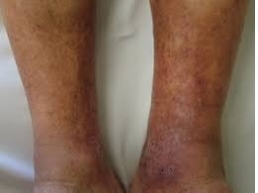Lipodermatosclerosis
What Providers Need to Know
By Timbre Backen, DO PGY2
Etiology: a chronic form of stasis dermatitis resulting from venous hypertension that causes increased capillary permeability and allows leakage of fibrinogen and erythrocytes into the dermis. Risk factors include age, immobility, obesity, smoking, and history of DVT or trauma to the venous system.
Symptoms: - Acute phase: painful erythema, typically at medial ankle region.
HOW TO DIFFERENTIATE FROM CELLULITIS?
Lipodermatosclerosis typically presents with indolent development over weeks to months and frequently involves both legs. Cellulitis is most often an acute reaction to a specific trigger. -
Chronic phase: hyperpigmented red-brown or violet-brown discoloration and indurated skin that constricts the ankle region, resulting in an “inverted champagne bottle” appearance.
Diagnosis: clinical, often seen with other symptoms of venous insufficiency including venous varicosities, pitting edema and hyperpigmentation. Biopsy is NOT recommended due to concerns of poor wound healing in the setting of venous insufficiency.
Treatment:
CONSERVATIVE MANAGEMENT - Compression therapy: 20-30mmHg knee-high compression stockings - Leg elevation and exercise - Skin care
Go Back Symptoms: - Acute phase: painful erythema, typically at medial ankle region.
HOW TO DIFFERENTIATE FROM CELLULITIS?
Lipodermatosclerosis typically presents with indolent development over weeks to months and frequently involves both legs. Cellulitis is most often an acute reaction to a specific trigger. -
Chronic phase: hyperpigmented red-brown or violet-brown discoloration and indurated skin that constricts the ankle region, resulting in an “inverted champagne bottle” appearance.
Diagnosis: clinical, often seen with other symptoms of venous insufficiency including venous varicosities, pitting edema and hyperpigmentation. Biopsy is NOT recommended due to concerns of poor wound healing in the setting of venous insufficiency.
Treatment:
CONSERVATIVE MANAGEMENT - Compression therapy: 20-30mmHg knee-high compression stockings - Leg elevation and exercise - Skin care
